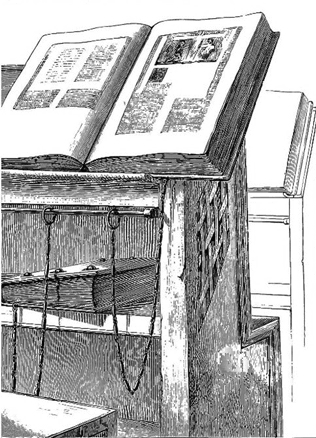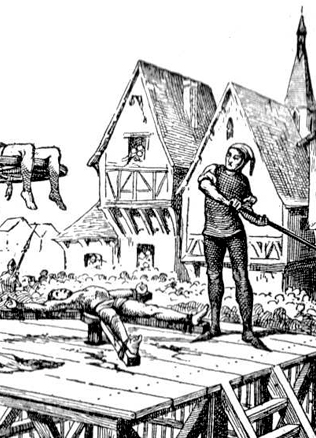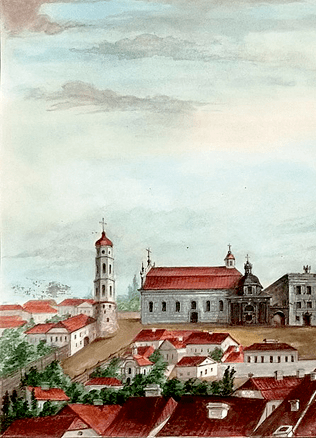When Women Ruled over Men… Lutheran Vilnans in the Jesuit Satires of the First Half of the 17th Century
The society of the Grand Duchy of Lithuania was extremely diverse in ethnic, religious and cultural aspects until the middle of the 17th century. The diversity was especially obvious in largest cities and Vilnius, the capital of the GDL, was one of them. Due to various reasons, the subsequent development of the society had its course towards uniformity, which means that the number of Poles and Catholics (including Unites) was growing, while other social formations, except the specific ethnic and religious group of Jews, were diminishing. The processes that took place at the turn of the 17th century were behind that situation.
Reading anti-Lutheran satires written by the Jesuit professors of Vilnius University between 1620 and 1642 helps understand what was the image of people of other faith (Lutherans) and other ethnic background (Germans) that the Catholic society was promoting in the first half of the 17th century, the transitional period from tolerance to intolerance. The texts which reflect hostile, aggressive and malicious mockery belong to the even larger group of polemic texts targeted against all individuals of other faiths, including the Protestant, Orthodox, and Jews. Their authors used stereotypes to taunt them and to depict them as “non-humans” who do everything in contradiction to the norm, in other words, they are all alien and abnormal. Due to objective and subjective reasons, the authors of these satires were rarely interested in reflecting reality. Creating an imaginary and funny reality by means of grotesque and parody was what they really wanted. It was that ‘noble goal’ – the mockery of ‘heretics’ – that would force the otherwise solemn Jesuits to make an exception for themselves.
Lutheran “immoralities” through the eyes of Catholics
The first thing the satires against Protestant Lutherans living in Vilnius tried to exploit was their different national background (they were from Germany), in addition to the key “evil,” their Lutheran faith that the Jesuits considered a religious subculture. Satirical characters speak distorted Polish and bear intentionally garbled names. The lack of patriotism is one of their key shortcomings. The satires underline the fact that their preachers arrive from German cities of Königsberg and Wittenberg. The attempts to identify Protestants with Germans reflects the traditional stereotype of Martin Luther, who was German, and a certain kind of narrow-minded nationalism characteristic not only to Catholics. For instance, this is how the Orthodox resident of Vilnius attempted in 1666 to threaten a German Lutheran from Cologne: “I will make that German ride the Turkish horse today”, meaning “I will hunt him away”. The authors of the satires were intentionally blind to the fact that the German Catholic community had been living in Vilnius for many years; many Lutherans spoke Polish only and they had their personal pastor, a Pole. On the other hand, there were a number of Germans among Jesuits themselves. German identity here is nothing more than a stereotype that essentially becomes equal to Lutheranism in the distorted reality of the satires.
The authors of the satires, the Jesuit monks, express their genuine astonishment and revulsion whenever the participation of lay people in the operation of the Protestant Church is concerned.
The authority of women within their society and the Protestant Church was another popular yet largely incorrect idea. The satires offer parodies on wives of pastors who manipulate their husbands, take active part in theological discussions and arrange “secret councils,” the latter being a popular parody on the Protestant Synod often characterised by low morality. The message is that Lutherans in Vilnius are under women rule. This is how the Jesuits wished to influence Catholic men with patriarchal upbringing. The authors of the satires, themselves used to strict hierarchy within their Church, scoffed at debates between Protestant preachers who often allowed lay people to take an active part. The Jesuits use every opportunity to demonstrate that the participants of those discourses have very little idea about the matters they are discussing. The satires also point out certain details of different lifestyle, including the meals the Protestants consume, their neglect of fast and the clothes they wear, such as hats.
The real and the fable in the Jesuit satires
Although in most cases the things depicted in the satires have nothing in common with reality, they reflect in perverted form many customary, social, political, topographical and linguistic realities of the society of that time through the exploitation of religious, ethnic and sexist aspects. For instance, the mockingly contorted personal names usually conceal real historical personalities, including Lutheran clerics and lay men and women. Some events taunted by the Jesuits are real. For instance, the Lutheran preacher M. Burchard did actually die after falling down a ladder; a raw between Lutheran preachers did actually take place in 1641 and it involved some senior lay people.
The Jesuits tended to overstate the things their ‘normal” society lacked.
Their anti-Lutheran satires provide a lot of information about Catholics too.
For instance, whenever the Jesuits and men would make fun of women ‘terrorising’ Lutheran men, they in fact tried to consolidate their own sex-based hierarchy.
The juxtaposition of Lutheran citizens against their Catholic counterparts in regard with their religious beliefs using categories such as “us” and “them,” “locals” and “strangers,” “normal” and “abnormal” did not correspond reality. In real life, Lutherans had preserved many aspects of Catholic faith. Both they and Catholics lived in the same world of sanctity, magic, demons, sacred signs and order. For instance, Lutherans were positive as far as the cults of the Mother of God and of some saints were concerned. Lutherans and Catholics were in constant communication every day. For instance, the character of one of the satires Mateusz Lettow who, according to the Jesuits, was eaten by Lucifer when he mistook Mateusz for a pill, had a son Maciej, the future municipal assessor and royal physician, who back in 1610 even attended Vilnius University run by the Jesuits. In his memoires he says he felt hostility only once when he happened to meet an immigrant from Spain. His memoires reveal that there was no overwhelming antagonism in Vilnius, although one might think the opposite reading the satires. In some occasions, even Catholics themselves, including advocati, burgomasters and other officials of Vilnius together with their wives, took part in the ceremonies when Protestants – both Lutherans and Reformed Evangelicals – baptised their babies; sometimes Catholic officials would choose to become godfathers or witnesses. Even King Wladyslaw IV Vasa and his Catholic courtiers would agree to become godfathers. This is a yet another example of ties between the elites where intolerance was traditionally less common. The aforementioned satires were aimed primarily at the Catholic crowd, the potential participant of pogroms.
Literature: A. Ragauskas, XVII a. pirmosios pusės Vilniaus liuteronų subkultūros atspindžiai jėzuitų satyroje, Lokalios bendrijos tarpdalykiniu požiūriu, Vilnius, 2004, p. 45–54.
Aivas Ragauskas



